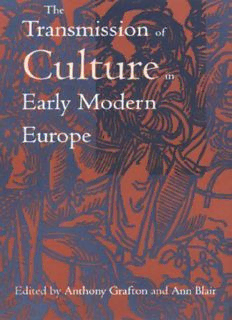
The Transmission of Culture in Early Modern Europe PDF
Preview The Transmission of Culture in Early Modern Europe
The Transmission of Culture in Early Modem Europe Published under the auspicesof the ShelbyCullomDavisCenterforHistoricalStudies PrincetonUniversity The Transmission of Culture in Early Modern Europe Editedby Anthony Grafton andAnn Blair PENN University of Pennsylvania Press Philadelphia Copyright © 1990UniversityofPennsylvaniaPress Allrightsreserved Printed intheUnited StatesofAmericaonacid-freepaper 10 9 8 7 6 5 4 3 2 I Publishedby UniversityofPennsylvaniaPress Philadelphia, Pennsylvania19I04-40II LibraryofCongressCataloging-in-Publication Data TheTransmissionofcultureinearlymodern Europe / Anthony Grafton andAnnBlair,editors. p. cm. "Published under theauspicesoftheShelbyCullomDavisCenter forHistorical Studies,Princeton University?' Includesbibliographicalreferences. ISBN 0-8122-8191-8(cloth) ISBN13:978-0-8122-1667-7 I. Europe- Civilization. 2.Europe- Intelleetuallife. 3.Culture diffusion- Europe- History. 4.Grafton,Anthony. 5.Blair,Ann. 6.ShelbyCullomDavisCenterforHistorical Studies. CB203.T3 1990 940.2-dc20 89-70750 CIP Contents Acknowledgments Vll Introduction: Notes from Underground on Cultural Transmission Anthony Grafton 1 I. Invention ofTraditions and Traditions ofInvention in RenaissanceEurope: The Strange CaseofAnnius of Viterbo Anthony Grafton 8 2. Inventing Rudolph Agricola: Cultural Transmission, RenaissanceDialectic, and the Emerging Humanities LisaJardine 39 3.Cortes, Signs, and the Conquest ofMexico Inga Clendinnen 87 4. "Second Nature": The Idea of Custom in European Law, Society, and Culture DonaldR. Kelley 131 5.The Making of aPoliticalParadigm: The Ottoman State and Oriental Despotism LucetteValensi 173 6. CivicChivalryand the English CivilWar WilliamHunt 204 7.Theology and Atheism in EarlyModern France Alan CharlesKors 238 8.Honor, Morals, Religion, and the Law: The Action for Criminal Conversation inEngland, 1670-1857 LawrenceStone 276 Contributors 317 Index 319 This page intentionally left blank Acknowledgments Wewould like to thank Lawrence Stone and Joan Daviduk for help of many kinds; also the Department of Rare Books and Manuscripts of Princeton University Library, whose staffprovided most of the illustra tionswith miraculousspeedand efficiency. This page intentionally left blank Anthony Grafton Introduction: Notes from Underground on Cultural Transmission IwasinaPrinting house inHell, & sawthe method inwhich knowledge is transmitted from generation to generation. In the firstchamber wasaDragon-Man, clearingawaythe rubbish from a cave'smouth; within, anumber ofDragons werehollowing the cave. In the second chamber wasaViper folding round the rock&the cave, andothers adorning itwith gold, silverand precious stones. In the third chamber wasanEaglewith wings and feathersofair:he causedthe insideofthe caveto beinfinite; around were numbers ofEagle likemenwho built palacesinthe immense cliffs. In the fourth chamber wereLions offlamingfire,raging around & melting the metalsinto livingfluids. In the fifthchamber wereUnman'd forms,which castthe metalsinto the expanse. There theywerereciev'dbyMen who occupied the sixthchamber, and took the forms of books & were arranged inlibraries.1 WilliamBlake,TheMarriageofHeavenandHell Unlike Blake, most nineteenth-century scholars saw the creation of cul ture as distinct from and more interesting than its transmission.' Jacob Burckhardt, for example,treated the culture of the Renaissance as an es sentiallynew creation rather than a mere revivalof an ancient one, and deliberatelyrelegatedthe studyofthe classicsto alateandsubordinate po sition inhiswork. "The essenceofthe phenomena," he remarked, "might havebeenthe samewithout the classicalrevival."3This attitude, rooted in Romantic beliefsabout originality and intensity, died hard; but between 1870 and 1914 it gaveup the ghost. In its place arose a new scholarship centrallyconcerned with the transmission oftexts,images,and ideas. AbyWarburgandthescholarsassociatedwiththeinstitute hefounded tracedwith the zestand intuition ofdetectivesthe shifting paths taken by classicalideas and forms in the worlds of Islam and the Western Middle Ages.Literary scholarstrackedclassicaltopoi from text to text. Iconogra-
Description: